How the myth of the Romantic artist has shaped the way we work, and how it could define working habits of the post-pandemic world.
Au déboulé garçon pointe ton numéro Pour gagner ainsi le salaire D’un énorme jour utilitaire Métro, boulot, bistro, mégots, dodo, zéro.
Hurry boy punch in your number To earn the pay Of this great productive day Subway, work, diner, fag-ends, kip, nothing.
Pierre Béarn, extract from Couleurs d’usine, 1951
Almost fifty years separate the Paris riots of 1968 and the opening of the first WeWork office – but both events could prove useful in preparing for the next revolution in our working lives, which may have already begun.
Under pandemic-induced lockdown, the world of work has experienced dramatic change. Many workers have already lost their jobs, with no guaranteed return. Up to 1.5 billion workers have spent the past months on government-supported garden leaves. Many more are finding ways to work from their kitchens or bedrooms. Only for those whose work has been deemed essential, it’s business as usual – save perhaps for a new level of anxiety and risk.
The systemic shock has led to calls for a wholesale reconfiguration of conditions of labour and reevaluation of the role of work in our lives. While some changes, for example the increase in popularity of home-working, are almost inevitable, it is unlikely that the Covid-19 recovery plan will bring about the labour revolution heralded by Karl Marx. Instead, any significant changes are likely to follow the same patterns that shaped work in the past century, when the labour market adapted to shocks like the aftermath of the Second World War or the 2008 global financial crisis.
The Romantic myth of the 19th century bohemian artist-intellectual has been the underappreciated blueprint for evolutions in the labour settlement. The Baudelairean flâneur lifestyle is echoed in the design of ‘gig’ work Intellectual creativity is a key commodity of the knowledge economy. The 21st century office environment itself emulates an artistic workshop.
For all its promise of glamour and freedom, the mythical artistic lifestyle is riven with insecurity, anxiety, and competition, while offering only a simulation of release from the demands of capitalism. And yet, artists have often been keen to forego security in pursuit of autonomy, often to breaking point. They volunteer to work longer hours in damp studios on a patchwork of poorly-paying projects whose main reward is often the unquantifiable sense of social relevance or peer recognition.
As capitalism has continually exploited artists’ willingness to make sacrifices in pursuit of their desires, understanding how this mythology plays itself out in the labour marketplace will be key in negotiating the role of labour in the coming months and years.
Eat, work, sleep, repeat
Métro, Boulot, Dodo, the sarcastic slogan of the 1968 Paris protests, roughly translated as Commute, Work, Sleep, encapsulated a central demand of France’s general strikes: liberation from the drudgery of monotonous work. In the decades prior, Europe overcame the economic losses of the Second World War, fueling and eventually fulfilling mass consumer demand.
In fact, the worker’s perennial struggle for dignity, good pay and equitable working conditions had never been fulfilled, despite the economic boom of the swinging sixties. The intoxication with consumption went some way to alleviate the inequalities that lingered in post-war Western societies, but these effects could only be short-lived. Like yin and yang, as consumption grew, so inevitably did pressures on productivity and profit, demanding new sacrifices of the workforce.
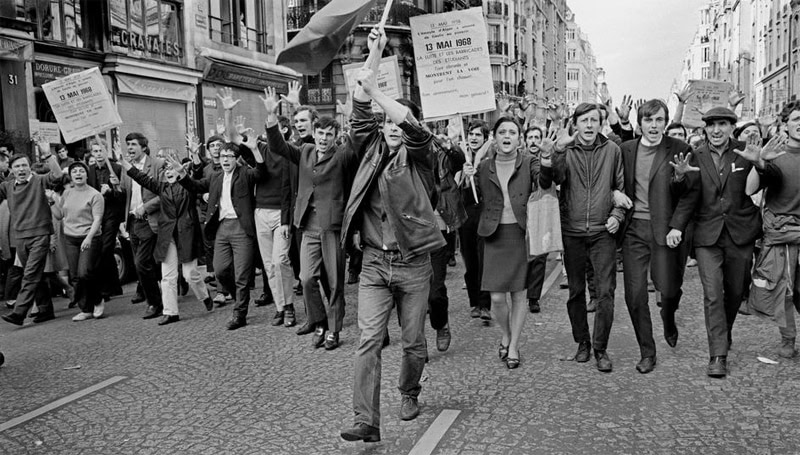
This rise of consumer culture also had its detractors amongst the intellectual classes who saw it as hollow and unfulfilling. Indeed, commodity capitalism was one of the central concerns of the March 1968 student occupation of a Paris university campus. Concerns over teaching conditions and a heavy-handed police intervention were a perfect catalyst for the demonstrations to spread to the streets, winning the support of fellow students, artists, and public intellectuals.
Pierre Bourdieu[1]Pierre Bourdieu, The Rules of Art : Genesis and Structure of the Literary Field, 1992 traces the intellectual opposition to capitalism’s uniformity to the 19th century idea of the bohemian artist. The emancipated, carefree and intoxicated antics of the Montmartre circle painters like Henri de Touluse-Lautrec or the bad-boy of poetry Arthur Rimbaud have been emulated and caricatured since. The artistic class rejected the bourgeois pursuit of status and uniformity, favouring instead autonomy and authenticity.
For the artist, this meant a reluctant rejection of the spoils of progress: comfort could not be compatible with true freedom. This ideal, as old as the Romantic poet himself, continued to influence avant-garde artistic movements of the 20th century and shaped intellectual attitudes of the French academy.
In Paris, the particularly French phenomenon of sympathy strikes helped factory workers seize the moment of student unrest to articulate their desire for improved working conditions and pay. Soon, the discord escalated to a wave of nationwide strikes involving all major industries. Workers joined the student marches, and by May 1968, the entire country’s economy came to a standstill.
The two emancipatory desires of labour and intellect become entangled and indistinguishable in historical memory of 1968. Portrayals, amongst them Bernardo Bertolucci’s film The Dreamers in which the very electric atmosphere of Paris births late-night conversations about political film, heroic banner-waving, and love triangles, give the impression that the protests were Western Europe’s last truly universal liberation movement.
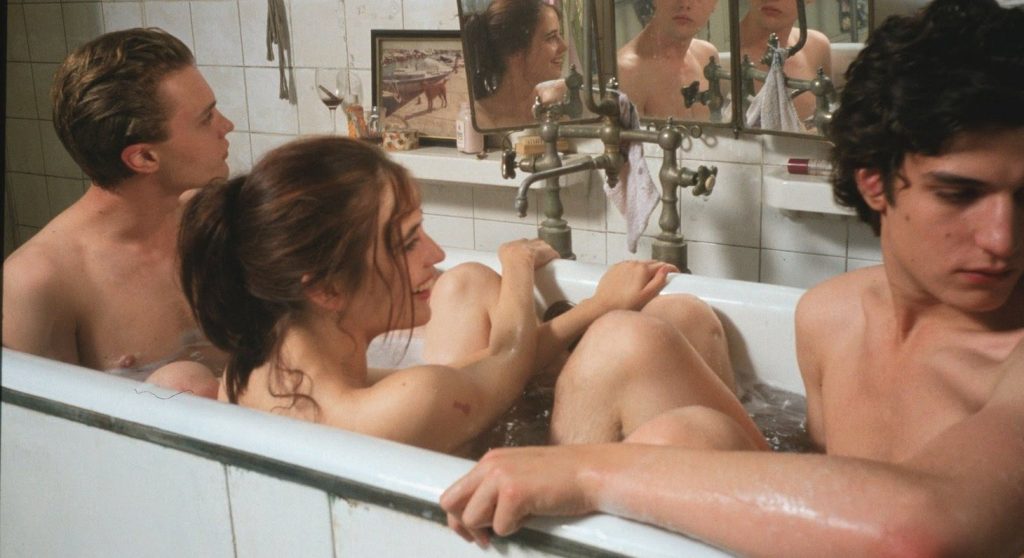
In reality, the ideological objectives of the students and the labour force had little in common. Workers were sympathetic to the students’ protest against France’s class divisions or loss of individual autonomy, but this alone would not have led them to down tools. The intellectual elites could not have in earnest acted as the representatives of the working class either. By late May 1968, the labour unions settled for a 10% pay rise, and workers returned to the factories. The student protest inevitably died down too, arguably without achieving its goals.
Choice, freedom, autonomy
Adjustments in the relationship between labour and capital have been a periodic feature of market economies since the industrial revolution. This moment is relevant today not merely because the 1968 general strikes brought industry to its knees much as our Covid-19 furlough economy is doing now, but because its mythical status has helped to define the nature of work in ways which only became evident in the 21st century.
1968 is symbolically important because of the way it involved artists, students and intellectuals along the factory workers. The short-lived collusion of workers and intellectuals came to an end before it had time to develop a common language, but it lingers in contemporary consciousness.
In response to 1968, capitalism embraced the challenge of providing each individual with precisely the set of freedoms and conditions they were willing to bargain for. According to sociologists Luc Boltanski and Eve Chiapello,[2]Luc Boltanski, Eve Chiapello, The New Spirit of Capitalism, 1999 the demands of 19th century artists were finally met in the synthesis of the authenticity and labour dialectic. Post-1968 capitalism conceded levels of individual autonomy that would have been unthinkable to Bourdieu’s bohemian.
The invisible hand of the market provided an efficient pricing mechanism for balancing mainstream values and true individual authenticity. To those who could not afford this transaction outright, it exposed the capitalist condition’s inherent denial of authenticity and autonomy and offered a substitute.
For the worker, the transactional nature of the new settlement manifested itself in the accelerating cycle of consumption and production of choice. For a generation that forgot the suffering and inequalities of the Second World War, labour was no longer merely a means of survival. Choice became the driving force in the development of markets and diversification of consumer tastes, as well as the neoliberal policies and economic environment that nourished them. Deregulation and developments in technology made it possible for mass-produced goods and services to reach consumers in forms which satisfied this taste for choice. According to Noam Chomsky,[3]Edward Herman, Noam Chomsky, Manufacturing Consent: The Political Economy of the Mass Media, 1988 advertising, whose power grew with the reach of television, forced individuals to behave irrationally, redirecting their will and desires precisely where they would be fulfilled for profit.

The artist was left none the better off either. Whereas for the bohemian, authenticity could come from a simple act of opting out from consumption, now freedom was reconstituted as dependent on exercising choices in an authentic fashion. The triumph of choice is that it offered a semblance of freedom and control, delivering to each individual an experience matching their own price point.
Tipping the pyramid
The bohemian ideals of freedom and authenticity could now permeate the factory and the office too. Management theories propose a plethora of ways to motivate workers. Abraham Maslow’s classic pyramid hierarchy of needs, for example, suggests that an individual’s most basic requirements – sustenance, shelter, safety – must be satisfied before they seek intellectual or emotional fulfillment. The worker’s salary, then, first secures sustenance and shelter, while safety is a matter of working conditions. When these are adequate, the worker is free to exercise individual choices in pursuit of self-actualisation, in a process that is extrinsic to work itself.
To the worker-consumer of the late 20th century, work is thus only a means to acquire freedoms. Any positive side-effects of the worker’s emotional or intellectual fulfillment outside of the workplace, such as increased productivity, are returned to the workplace voluntarily.
But what if it turned out that one of Maslow’s human needs could be played off against another? Could the engaged, fulfilled worker be compelled to labour with the same productivity for a lower salary in return for enhanced self-actualisation potential? What if this self-actualisation could also become part of labour itself, rather than a private good? And what, perhaps, if the self-actualisation could be made to reproduce and reinforce itself, at no great cost to the employer?
Against a backdrop of weakening social and family bonds, the 21st century workplace is a perfectly promising arena for the pursuit of belonging and self-actualisation. Those workers lucky enough to have been freed from the drudgery of the factory line by the West’s move away from manufacturing into the knowledge economy now look to their employers for recognition, validation, and even emotional fulfilment.
The ethos of the bohemian artist – think now of the 1960s Manhattan warehouse loft – came handy in shaping the corporation’s response. Team building exercises and paintball games complemented structural innovations that would nurture the individual. New ideologies of work, manifested in the freedom-inducing, open-plan, warehouse-style offices, encouraged the flow of emotion as much as of information.
In No Collar,[4]Andrew Ross, No-collar: The Humane Workplace and Its Hidden Costs, 2004 an account of the American workplace at the turn of the 21st century, Andrew Ross observed that when the New York’s startup scene made the break from the cubicle office of corporate America, employees valued the open social and cultural design of the workplace for its potential to fulfil their human aspirations, sometimes ahead of the economic value of their own work. Ross describes one media company’s employees as ‘artists’ who made for better workers precisely because they had internalised the transaction between personal fulfilment and monetary rewards. Just like the bohemians, they were cheaper and more committed to their work.
By the time the dotcom bubble burst, its artist-workers realised that their sacrifices served only to reinforce corporate America’s reach. The ‘perks’ of airy offices – soon the standard model around the globe – did more to extract productivity than they did to free the workers.
The freedom-through-work paradigm turned out to be illusory, just as choice and consumption had earlier. By the 2008 financial crisis, the worker had again lost control of the only recently-earned privilege of trading pay for authenticity, and the human need for individuation was fair trade both in the workplace and in the private sphere.
Hour zero
Pierre Béarn’s poem Couleurs d’usine, which inspired the 1968’s protest slogan, inadvertently prophesied another aspect of work that came true in the 21st century: the factory, commute, and sleep intensified to fast food, fag-ends, and eventually led to zero.
The foundation of today’s ‘zero hours’ and ‘gig’ economies is the transaction between freedom and morality. To participate in the market, the emancipated worker agrees to avert their gaze from the more egregious injustices of capitalism, such as the ongoing colonial exploitation of developing economies or gender inequality. Morality thus becomes a matter of transaction, and the individual may further consent to become the subject of some form of systemic injustice, in return for another consideration.
To the now ‘casual’ worker keen to recover from the post-2008 depression in the labour market, flexibility and mobility are presented as synonymous with control and success. A portfolio career of multiple part-time or gig jobs could, in principle, be a way to avoid the malaise of alienation from labour, or offer space for family commitments, study or other pursuits.
This appearance of control and choice distract the worker from the costs of non-traditional labour: the often low earnings, unregulated working conditions, and lack of stability. This makes micro-entrepreneurialism a popular political aim; in the UK, for example, the welfare and education systems encourage self-employment without regard for the viability of the underlying business plans. In the early 2000s, a plethora of freelance web designers, personal trainers, delivery riders – and artists – were to be the masters of their own lots.
This freedom had to be paid for – not even the bohemian would have expected such choice and autonomy to come free. In the algebra of emancipation, this is a step back: while Bourdieu’s artists could in principle opt out from exploitative capitalist conventions, the contemporary worker must first labour in the extractive system to earn the right to distance himself from it.
Certainly, that Romantic model appears more attractive. The seductive myth of the artist – late on rent but always up for a party – gave the impression that the bohemian lifestyle was shielded from destitution. In fact, many of those bohemian lifestyles and the intellectual productivity they afforded were bank-rolled with other people’s money. The archetype of the Montmartre artistic scene Henri de Toulouse-Lautrec, for example, was an aristocrat. William S. Borroughs, one of the great American bohemians, came from a well-established family, and Jack Kerouac, the ultimate bohemian drifter, actively fuelled speculation on his noble roots.

Were Bourdieu’s bohemian to swap places with his 21st century successor, he might find the economic precarity-as-lifestyle a lot less alluring. Despite the harsh realities of maintaining a sense of autonomy while making a living in late capitalism, artists have continued to reproduce the Romantic myths of the bohemian visionary. The explosion of the international art market that brought stardom and wealth to a handful of artists who acquired the status of rock stars, making the myth of an artistic life still more desirable.
Altermodern, the 2009 Tate Triennial curated by Nicholas Bourriaud lauded contemporary artists as hyper-connected, interdisciplinary, multicultural mobile agents that, today, in light of the fraying of globalism, looks like jaw-dropping naivité. Never mind the damage this idea has done to a generation of artistic cadres in promising pseudo-intellectual satisfaction in return for an air fare: 21st century capitalism would adapt this artistic mythos to create a new value translation between labour, freedom, and creativity.
Everyone is creative
“Everyone is creative,” proclaimed a 2001 paper by the UK’s Department of Culture, Media and Sport. In New Labour’s optimistic vision, creativity and the creative economy were Cool Britannia’s unique selling strengths. Britain was to become a nation of games designers, filmmakers, web creators, and – in preferably smaller numbers – artists, all ready to export their creativity.
Heavy public and private investment in creative education, film, games, and design industries followed. As a perverse by-product of this supply-side ideology, by the latter years of the 2000s, London’s coffee shops were filled with graphic designers, but they were the ones making the coffee, rather than hot-desking over flat whites.
Creativity, independence and enterprise, embodied by the creative startup founder folded over a laptop in the corner of the high-brand-values coffee shop, endured as an aspirational ideal for all work. Startup by startup, everything would be disrupted, improved, re-monetised. Taxis, hotels, banking, shopping and dating all changed beyond recognition.
Disappointingly, all these revolutions did not render work obsolete. But WeWork, the most notorious disruptor of late, was poised to reshape the world of work itself forever. Its weapons? Flexibility, creativity, and free beer. WeWork’s central idea, inspired by founder Adam Neumann’s childhood at an Israeli kibbutz, is that every worker should find fulfilment in a collective experience of labour without losing their sense of authenticity. The office couldn’t offer the rewards of proximity to the land, but it could mimic another rural utopia: the artistic colony.
Inner-city pastoral
At the turn of the 19th century, artists flocked to scenic villages of the Netherlands, Germany and France, where they could commune with nature and with their muses. Romantic art is rife with images of comradery between peasants and intellectuals; the countryside, far away from the bourgeoisie’s petty concerns, was the perfect setting for both intellectual and physical labour.
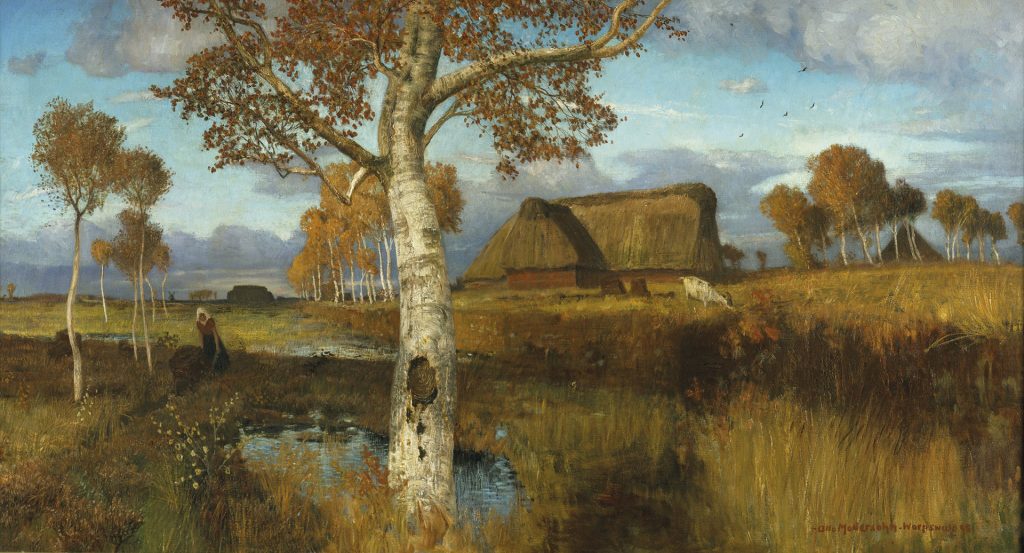
Just like the art colony, the WeWork office blurs the boundaries between toil and art, except where the artists once played at farming, office workers now get to pretend to be artists. This would be a fair exchange, except that where the painters at the colonies at Worspede, Skagen or Nida would derive inspiration from the countryside but stop short of performing any agricultural labour, the office workers are required to perform their traditional office duties and now hand over the results of their creativity to their employer too.
By providing an environment that, like the rural idyll, stimulates the body and the mind, WeWork creates spaces in which workers become entrapped: their days stretch out in a rhythm of coffee meetings, community events and pinball tournaments. And WeWork is only a shadow of the office design trends pioneered by technology giants over a decade earlier: the Googleplex, for example, boasts swimming pools and laundry facilities, and the Apple Park is larger than the Pentagon.
Scale can be blinding – WeWork has a portfolio of almost 850 properties – and it conceals the fundamental differences between the working conditions enjoyed by employees at Google and those hot-desking for a startup. Those Googleplex swimming pools – just as the salaries and healthcare plans of the ranks of software developers – come at significant cost. Few employers can justify such expense in the name of talent retention alone. For the majority of office workers, colourful sofas and table football games have to do.
To create spaces that adapt to their users’ needs, nurturing and shaping their productive impulses – that is to increase productivity – the office behemoth hired an army of architects, including the Danish star Bjarke Ingels who had co-designed Google’s New York HQ. For all of WeWork’s radical architectural ambitions, it could have got by with a lot less. In designing its Toronto offices, the software giant Autodesk used a generative design artificial intelligence system to produce interior layouts that took into account the needs of all parts of the business, down to the positions of succulents on the desks. Philosopher Theodor Adorno[5]Theodor Adorno, Minima Moralia, 1978 observed that even anti-bourgeois sentiment – the drive for authenticity – undergoes a process of standardisation. Artificial creativity is now indistinguishable from human creativity.
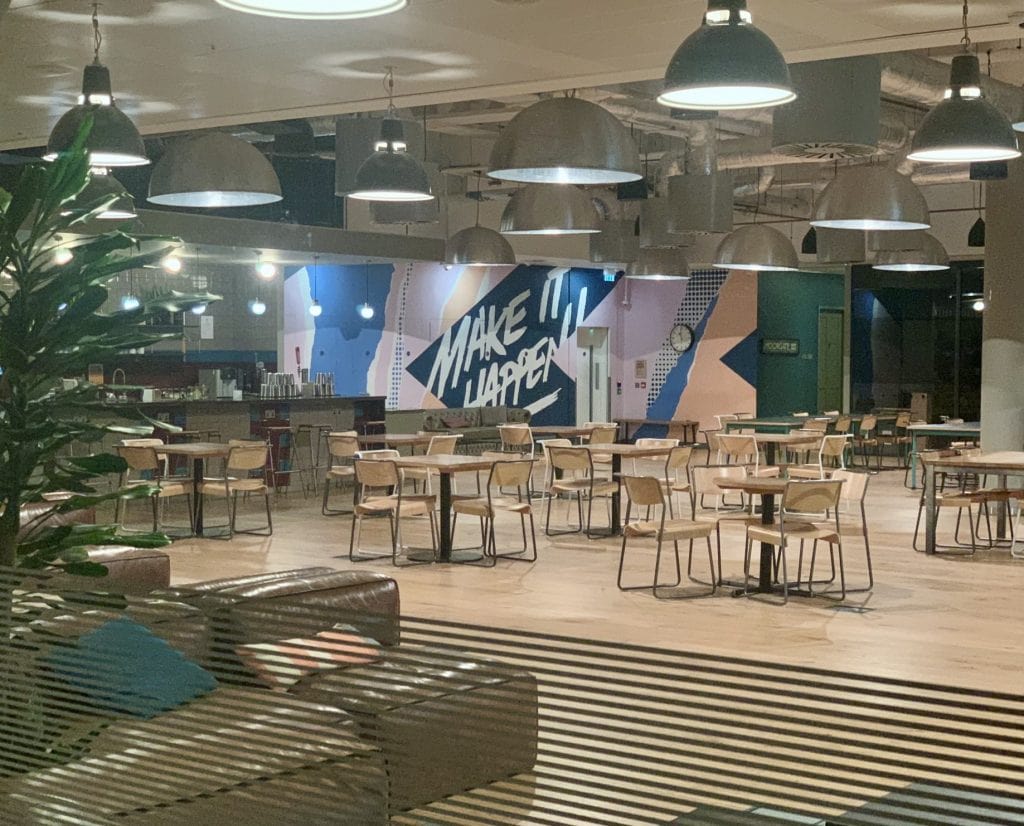
WeWork’s interiors are in fact banal copies of the coffee bars already familiar to their startup clients, shiny evolutions of last decade’s open-plan budget spaces which even accounting firms now want to escape from, softly infused with brand-appropriate representations of what an artist’s ‘creative space’ might look like. Luckily for WeWork’s tenants, the mere promise of creative freedom seems to satisfy much of an individual’s desire for it. The worker’s implied ability to endlessly customise their working environment is surprisingly fulfilling.
The language of creativity has permeated the world of office work. The ‘media-style offices’ of the 2000s are now ‘creative’ or ‘maker’ spaces. But when the employee shapes their environment, they do it just like an artist does in their studio: not to be happier, but in order to make more work.
Werther’s sorrow
Paradoxically, the more creativity is put to the service of the corporation, the less space there is for personal creativity, for art. Once work has commodified creativity, it could be leased back to the individual. Back at the art colony, the fruits of creativity were rewards in their own right, but in today’s office they literally become a trading card in a salary negotiation: a ‘creative marketing executive’ will accept lower pay than a ‘marketing officer’. Once again, to be a ‘creative’ artist became incompatible with being a worker.
To the truly bohemian artist, this would have been welcome news. In Geothe’s seminal novella Sorrows of Young Werther, the archetypal Romantic protagonist – a poet consumed by unrequited love – takes a position at the fringes of good society, his talent alone distinguishing him from the self-obsessed bourgeoisie or the non-intellectual idleness of aristocracy. When he is forced into employment, he suffers it with the greatest indignity, and prefers to fall back on his inheritance instead.
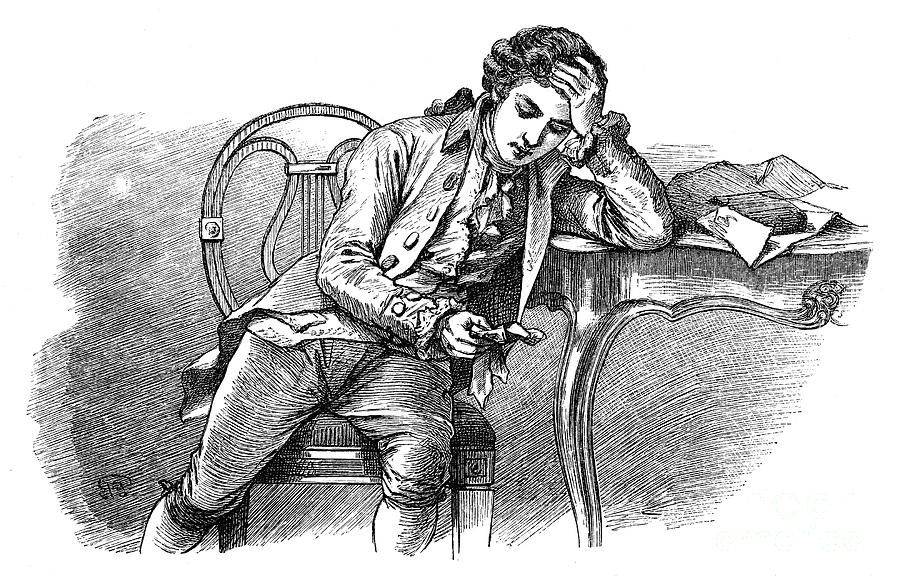
Should we have sympathy for Werther’s 21st century descendants? If we believe in the bohemian myth, art should be precisely the arena where existential limitations are overcome with the help of the muses. And art has of course evolved in line with – sometimes ahead of – its surroundings. Whether the creative industries comprising thousands of young Werthers graduating art and design schools every year can survive in the style of Goethe’s hero is a matter of supply and demand, education policy, and individual choice.
Today’s workers are encouraged to act like Werther, but without being offered even a shadow of the privileges he enjoys. Creativity requires an element of transgression – a principle understood by innovators and entrepreneurs – and with this carries risk. When workers are asked to apply creativity to tasks that are bound by rules they themselves have no power to negotiate, they have to internalise the corresponding dangers of failure. Werther’s end, despite Geothe’s best intentions, was pitiful.
The factory and the museum
The factory can be creative too. The BMW car plant in Leipzig designed by Zaha Hadid and opened in 2005 has received praise from architectural and business communities alike. Open and translucent, the building resembles a futuristic airport terminal more than a production line warehouse. Half-assembled car chassis gracefully glide over offices, lobbies and cafeterias as they travel to different parts of the production line.
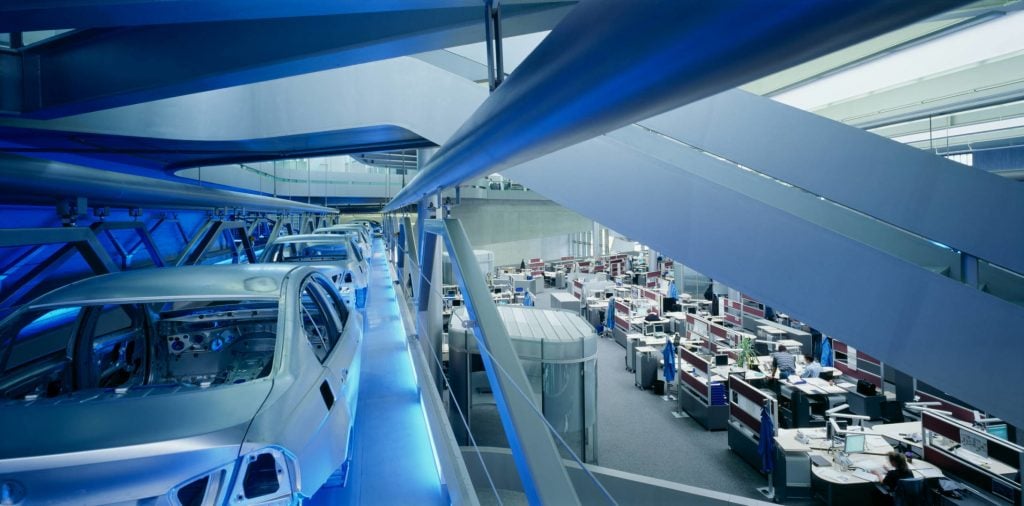
This conveyor belt parade of cars places the product in physical proximity to all workers. Administrators, marketers and accountants all see the fruits of their labour, and this must inspire the sense of accomplishment one can read into early utopian visions of manufacturing.
Hadid’s aesthetics of glass, polished concrete and matte white surfaces emulates the atmosphere of a museum or a laboratory, in which new knowledge and ideas are effortlessly conceived. Critic Mikkel Bolt Rasmussen[6]Mikkel Bolt Rasmussen, Globalization, Architecture and Containers in After the Great Refusal, Zero Books, 2018 notes that the transparent, single-level and circular nature of the production line encourages all workers to contribute to the BMW myth of great design. “It is not enough to tighten screws, you have to speak up, and be part of the collective enterprise. Workers must participate.”
The idea of blurring boundaries between a worker’s formal responsibilities and the wider success of the enterprise was pioneered in Japanese car manufacturing. Toyota prides itself on its culture of kaizen, ‘continuous improvement’, in which incremental changes to working practices contribute to increases in productivity and cost savings. In less hierarchical Western societies, workers are less likely to be incentivised by the promise of rises in profitability alone, but their contribution can be encouraged by symbolic means just the same. Zaha Hadid’s open-thinking factory harnesses the human impulses of creativity and self expression just like the WeWork office.
In what is surely an ironic twist to architectural histories, the fate of factories is to be converted into museums. London’s Tate Modern took over a disused power plant, Barcolona’s CaixaForum used to be a textile factory, and the city of Brussels is currently converting a former Citoën plant into a contemporary art museum.
Essential works
Work is transforming again right now. During the Covid-19 lockdowns, some workers have had to carry on as normal, some have found themselves surplus to requirements, and others are developing Zoom eye.
As workspaces reopen, we may have an opportunity to renegotiate which of our fundamental needs we are prepared to transact with. While it’s clear that safety – in Maslow’s hierarchy adjacent to nourishment – will become paramount, we should expect that this will come at a cost.
In classic supply-demand economics, one might have expected that jobs associated with higher risks – such as healthcare and public-facing services – should attract high wages. However, what we colloquially refer to as unskilled labour – which is often anything but – has been in such high supply in the past decades that the market doesn’t need to resort to reward systems that actually cost anything at all.
In the last three months, posters with and messages of support for healthcare workers hand-made by children have been appearing in windows across the UK. In Italy, communities have come together to laud their frontline workers in song. While carers and nurses remain some of the lowest-paid professional groups in the developed world, the public displays of hero-worship are society’s contribution to those workers’ sense of dignity and satisfaction in their labour.
The exchange rate here is cruel. To achieve balance, pay plus job satisfaction must be equal with the value of the labour itself and of any exceptional risk. As long as healthcare systems struggle to adequately protect healthcare workers, short of a pay rise, the children’s rainbows and musical ovations are the only compensation on offer.
Again, the self-esteem of essential workers can be commodified. It should not be a surprise that, just as WeWork was able to hijack individual creativity for profit, so can art. In East London, artist Peter Liversidge has been hand-making and installing hundreds of posters with messages of support for frontline workers in publicly visible sites. A touching gesture for sure, but as long as Liversidge’s displays contribute to the collective recognition of the value of essential work, they also syphon off some of the public appreciation for the workers’ sacrifices to the artist himself. Liversidge received significant media attention for his action, and his poster interventions are already in the inventory of the commercial gallery which represents him.
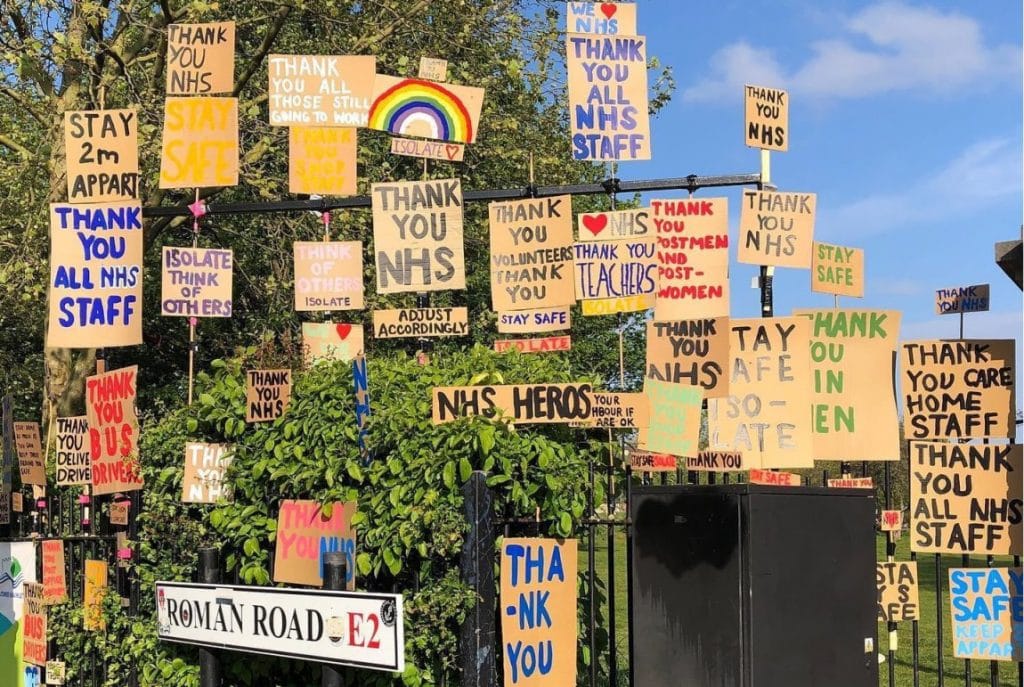
To virus-proof all workplaces as economies reopen will be a gargantuan task. What we know from previous shocks is that they demand flexibility of the workforce and encourage technological replacement of manual labour. Just when the pandemic-induced unemployment figures reach a peak, this tendency may reduce the demand for labour further. This technological evolution will likely contribute to the growth in inequality and encourage exploitation of those workers who are in the weakest bargaining position. There are, however, historical precedents which could be explored in the face of the labour crisis.
In the wake of the Great Depression, the most profound economic downturn of the past century, the economist John Maynard Keynes proposed that technological developments would allow a 15-hour working week abundant with leisure by 2030. Keynesian economics, a cornerstone of the early welfare state, enjoyed a resurgence after the 2008 financial crisis. Today’s governments facing not only flagging markets but also stagnant and hungry labour markets may look to Keynes for inspiration.
One of the settlements of the Great Depression was the introduction of the five-day working week. Such was the excess supply of labour that workers agreed to share what jobs there were, accepting lower pay for working fewer hours.
We could now be looking forward to a three-day weekend – a small number of companies have already been trialling such ideas and Finland had floated it as a potential policy even before the Covid-19 crisis struck. It is perhaps no coincidence that Keynes was the founding chair of what became Arts Council England, the UK’s public arts funding agency. This could almost have been a bohemian dream.
Zoom out a little
All along, a class of workers has been doing just fine in the crisis. For those engaged in dematerialised labour, a Zoom account has been enough to carry on. Marketers, project managers, software developers, account executives – but also customer service staff and teachers – have had to find ways to move their work online. For some, this is a realisation of an old dream. The sofa beats the commute, particularly when the newly-reopened metro already looks too crowded to feel safe.

In an attempt to ensure continued productivity, a handful of employers have instituted rigorous and potentially invasive performance monitoring measures such as policing workers’ use of social media and tracking their keystroke rates. These invasions are nothing new – corporations have always been able to read their employees’ browsing histories and Slack threads – and those businesses which have not visibly stepped up surveillance measures can rely on the threat of the panopticon webcam.
While a physical office enforces a rhythm of work – log in, email, catch-up, make a call – working from home makes some of these actions appear more arbitrary than previously. The new rules may take some adapting to, and some industries appear well prepared already. Twitter, which has announced that all of its 4600 employees will be able to continue to work from home indefinitely when the Covid-19 crisis has passed, is emblematic of the technology industry’s investment in remote working technologies and management techniques. This won’t be an option for everyone, but staying productive at home can be learned. Here again, we might look for tips to artists who have been finding inspiration alone in their studios for centuries.
Indeed, the Romantic artist could be the perfect Zoom worker: self-sufficient, inspired, determined, resilient, charismatic, and already used to spending most of their time without supervision or support. The recent global explosion of the art industry also means that art workers are used to collaborating with colleagues around the world, adjusting their expectations to new environments and conditions. If artists, whose education rarely includes specific training on managing studio time and international working can do this, couldn’t everyone?
What the Zoom workplace doesn’t offer is the social reinforcement of team meetings and pub outings with colleagues that are part of the implicit contract of employment. Some of this can move online – teams can spend their lunch hours playing Animal Crossing together, and some haven’t yet tired of Zoom cocktail hours – but the ability to mediate social relationships through physical space will be lost.
It turns out that artists are struggling too. After the initial tsunami of online initiatives, performances to camera and solidarity campaigns, many are feeling the erosion of their social networks just as much detrimental to their practices as the cancellation of exhibitions and projects that has impacted their already precarious livelihoods. Rachel Whiteread, one of Britain’s foremost sculptors, admitted that she is struggling to find a reason to work: “the things that make us human have been taken away from us, things like choice and decision.”
For now, we may have to amuse ourselves with customising our video conference backgrounds – the LA County Museum of Art handily released a range of images – and arranging our bookshelves to look suitably impressive. Come winter, we might have to ask just how starving artists have been getting on in their unheated studios all this time.
Cover image: The Artist’s Studio, Horace Vernet, c. 1820.
Notes

